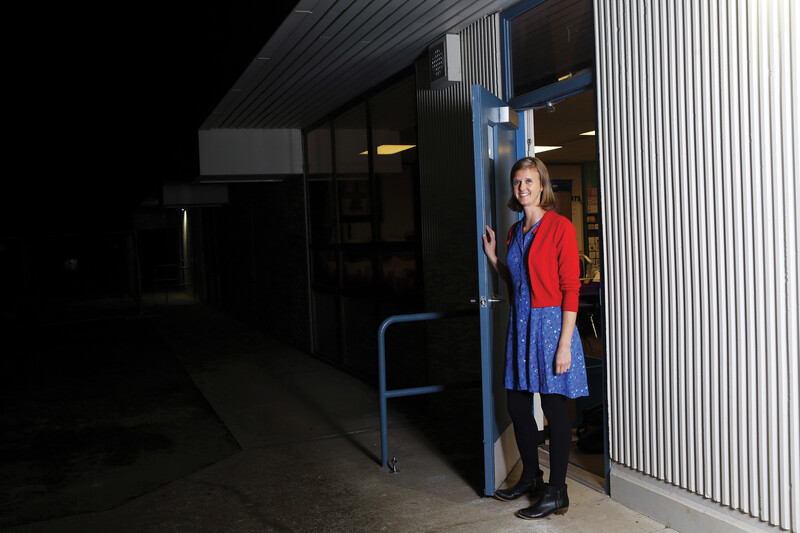Before the sun rises on weekdays, Keith Gebers hops into his car and traverses the Washington-Oregon border from his home in Kennewick, Wash. to Umatilla High School, where he works as a business teacher. He’s been doing the 23-minute commute for the last 23 years of his career. It’s a quick breeze into the tiny community of Umatilla where the roads are wide open and there’s just one stoplight in town.
Why does he choose to cross the state line? When he began teaching in 1995, Gebers applied to jobs in Richland, Wash., Connell, Wash., and in Umatilla, Ore. Umatilla School District was the first employer to call him back with an offer. Now close to teaching three generations-worth of students there, Gebers can’t imagine teaching anywhere else. At least for now. “I think about when I’m ready to retire, maybe doing the ‘retiree hire.’ I can get my 30 years in here and then go to Washington and finish up my career,” he says. Financially, Gebers’ plan makes tremendous sense. As a result of Washington state’s 2012 Supreme Court McCleary decision and effective bargaining by their local unions, Washington educators are currently earning, on average, 20 percent more than their peers
in Oregon.
What Went Down in Washington
In the McCleary Decision, the Supreme Court ordered the state of Washington to fully fund K-12 public schools as required by Article IX of the Washington Constitution:
"It is the paramount duty of the state to make ample provision for the education of all children residing within its borders, without distinction or preference on account of race, color, caste, or sex."
In McCleary, the Supreme Court ruled that the Legislature had failed to fulfill its constitutional obligation to 1.1 million students enrolled in Washington public schools. Two years later, the Court found the state in contempt for its failure to establish a plan for fully funding K-12 public education by Sept. 1, 2018. The Legislature failed to provide a plan, and the Supreme Court responded by fining the state $100,000 a day. By the time the 2018 Legislative session had drawn to a close, Washington lawmakers had increased state funding for public schools by billions, including $2 billion going toward educator salaries in the 2018-19 school year.

Even though he lives in Kennewick, Wash., Keith Gebers has taught at Umatilla High School for two decades. He keeps photos he receives from former students on his classroom wall; "They're a big reason for why I love teaching here," he said. "I still get pictures of them for their weddings, engagements, baby showers, military uniforms, etc... The wall is a perfect example of why I stay. It reminds me of the lives I've worked with, [students] who mean a great deal to me."
The dedicated work of Washington Education Association members to improve their quality of life was years in the making — but members are finally seeing their efforts come to fruition. WEA members in dozens of school districts across the state have negotiated double-digit percentage pay raises this school year. “It's going to take hard work. It's going to take courage. It's going to take organizing. But we must negotiate fair salaries for all WEA members,” said Shannon McCann, President of the Federal Way Education Association and a WEA Board member in the days following the passage of the state’s education budget.
Gebers sees the vast pay differential between Washington and Oregon even in his own family. His brother teaches in Kennewick and earns a base salary of $90,000 — plus overload pay, which equals $3.50 for every student over the set class load of 25 kids. All told, his brother’s salary amounts to around $112,000 — while Gebers, who has more than two decades worth of experience teaching, earns around $69,000 for the same type of work and similar years in the classroom.
For Gebers, though, teaching in Umatilla is about more than just the money. He’s passionate about the community and knows that loyalty to the students means a great deal to them and their families. Since he first began teaching in Umatilla, he's watched many colleagues exit the community to teach in Washington. To combat the trickle-out, Umatilla has launched a teacher pathway program to encourage local students to pursue an education degree and return to teach in the community. “In order to grow and retain these homegrown teachers, we really need to offer salaries that are comparable to what they could make 30 minutes down the road,” Gebers says.
Paulette Selman’s commute is similar to Gebers’ — although she’s driving in the opposite direction. Each day, she commutes from her home in North Portland to Ogden Elementary in Vancouver, Wash., where she works as a School Psychologist. She took the job four years ago after her former employer, Tigard-Tualatin School District, opted to condense her position — combining a 1.0 FTE Counselor position with a .75 FTE School Psychologist role. “I loved what I was doing, but it wasn’t sustainable for too long,” she says. “I’d never really thought of working in Washington, but I had a friend who worked for Vancouver Public Schools, and I decided to apply.”
At that point, the money wasn’t the biggest draw. “The attraction was that the district wasn’t as big as PPS [Portland Public Schools]. There were changes happening in Vancouver across a lot buildings, and school psychologists were becoming part of a system-wide change. Psychologists were part of things like PBIS [Positive Behavior
Intervention & Supports], Response to Intervention, and making improvements school-wide. That was attractive to me,”
Selman says.
Two years ago, Selman realized that there wasn’t a representative for school psychologists within her local association, the Vancouver Education Association (VEA). “There was this huge gap — our psychologist group was spending a lot of time trying to make things different in our district, but I realized nobody from that group was actually going to our union meetings. So, I started to go and got to know VEA’s leadership more.”
Since taking that initial step, Selman has lobbied on behalf of fellow school psychologists at the State Capitol in Olympia and attended the WEA Representative Assembly, where she represented all of Vancouver’s Educational Staff Associates (ESAs) — a category of educator identified in Washington that includes School Psychologists, Speech Language Pathologists, Occupational Therapists, Physical Therapists, Nurses and Counselors. At the RA last year, Selman learned more about the impacts that McCleary would have in the year to follow.
With the additional revenue coming from the Legislature, VEA’s Bargaining Team began meeting this past June to bargain adjustments to the salary schedule. Selman brought language to the team that also asked for big changes to ESAs’ caseloads (going from an average of 1,200 students down to 600). Selman and her colleagues nervously waited for updates from their bargaining team on Facebook all summer.
The first day of school was set for Aug. 29, 2018 — but with the bargain still open and educators’ salaries still on the table — VEA
members voted to strike, meaning the school year would not begin as planned. “The day we actually voted to not open the school year
was so exciting, just in terms of the energy that people were feeling — we really are going to stand together on this and stand for what we think is the appropriate salary increase,” Selman remembers. VEA members were not alone — educators across all of SW Washington were in a similar position. More than 6,000 educators in eight different school districts (Longview, Evergreen, Washougal,
Vancouver, Camas, Hockinson, Ridgefield and Battleground School Districts) were collectively on strike at the same time. According to WEA staff, approximately 1,600 of those educators live in Oregon.
“We were out for four days, and on that fourth day, we had a union membership meeting and voted to accept the proposal, which meant we could go back to work the very next day,” Selman says. The Vancouver deal included a 12.5 percent salary increase for all employees and passed with 93 percent approval from the membership. The support from the community was tremendous during that period, Selman says — hundreds of parents signed an affidavit stating they supported the actions of VEA members and that their students were not being irreparably harmed by the strike.
How did the experience impact Selman? “Well, I’m getting paid more. I can see that, for sure. And as a psychologist group, we did get a better case load cap — they lowered it to 950 students. It’s a move in the right direction where we have not seen movement for years,” she says. Beyond that, the strike was empowering in ways Selman didn’t initially expect. “The teachers I work with are really passionate people and go above and beyond for our students. To stand outside and choose not to open the school year was so inspiring because I know how passionate this group is. It was so amazing to see this group saying, ‘we are worth it.’”
The actions of Washington educators — that collective spirit and hope for a better future — have been replicated in droves across the country, from South Carolina to Arizona to West Virginia. This year, teachers and education support professionals have united under a collective movement known as Red for Ed. It’s vision is simple: educators are working around the clock to make a difference in the lives of their students and are standing up to lawmakers to ask for better pay and school funding. Fueled and organized by the 3.3 million members of the National Education Association, and supported by communities across the U.S., Red for Ed has the potential to create systemic, lasting change for our schools.

For her second job, teacher Lindsay Dance moonlights by working with three-year-olds two evenings a week at Elmonica Elementary School in Beaverton.
The Effects on Oregon
Two years ago, Spanish teacher Lindsay Dance was nearing the end of her probationary period as a first-year teacher in the Beaverton School District. She remembers receiving warning of a layoff notice just a few months after Measure 97 failed, when school districts were left grappling for the revenue needed to maintain current educator staffing levels across Oregon.
“In March that year, I got a notice that said ‘Congrats on finishing your probationary year. Due to funding, you’re not guaranteed a job in the district next year,’” Dance says. She attended a meeting hosted by the Beaverton School District’s HR staff and they told her to prepare herself for a layoff. Thankfully, the layoff that year didn’t come to fruition (nor did the potential layoff notice she received last Spring, for the second time in a row) and Dance has been able to maintain her position as the Spanish teacher at West Tualatin View Elementary School where she’s now been teaching for three years.
After that first layoff notice, Dance began researching what it would take to become licensed to teach in Washington and even attended a group interview for teaching positions in Vancouver. She didn’t want to leave her school, but as a young teacher just starting out in her career, she knew the option to transfer might be necessary at some point.
West Tualatin View Elementary is one of the few International Baccalaureate (IB) elementary schools in the state, and one of the IB requirements is to offer Spanish language classes to all students, which gives Dance a sense of job security — since the school must provide Spanish classes to maintain its IB accreditation. But with the rising cost of living in Portland, Dance has had to take on a second job teaching a preschool program for migrant children in the district. “I work two jobs, and I work in the summer for some supplemental income. It’s hard to save on the one income. If there’s any big expense that comes up, the second income is necessary. Last year I had to pay $2,000 in car repair costs, and that was my preschool teaching money for three months,” she says.
She hopes that what happened in Washington will soon ripple across the border and that Oregon lawmakers will choose to invest in education in a similar way. The future is bright now in the world post-Election Day, with a Democratic supermajority in Oregon and a re-elected Governor who has committed to prioritizing education funding. Part of Gov. Kate Brown’s campaign promise included salary increases for all Oregon educators, and maintaining retirement security for public employees: "These are hard-working people. They give the best years of their lives to our kids. We want the most dedicated and determined people entering the profession, not people who can't find any other job," Gov. Brown has said.
Why the Union Matters
For Skye Hanna, an early-career Kindergarten teacher at Rosa Parks Elementary in North Portland, the union is key to her commitment to teaching. Though she struggles to afford her one-bedroom Portland apartment on her teacher salary, she also can’t imagine leaving her job for one that’s not part of a union.
It all goes back to Christmas day 2015, when Hanna had a seizure and collapsed in her home. She was rushed to the emergency room, where it was discovered she had a cancerous brain tumor. “I was able to use sick leave days from the union bank because I was off of work for four months, and then came back for half days, probably earlier than I should have. The health insurance was more than adequate. I love the union and will never leave it — I’d be scared to leave it. I had brain cancer, and they took care of me during that time — and they continue to have my back,” Hanna says.

Skye Hanna works on recognizing sightwords with a small group of kindergarten students. Hanna spends money out of her own pocket every month to outfit her classroom and provide her students the tools they need to learn.
Like Dance, Hanna takes on second jobs when and where she can — babysitting, pouring wine at the Blues Fest during the summer, and tutoring. Her student loans from both her Bachelor’s Degree and Master’s program total around $400 a month. The temptation to look for jobs in Washington is there, no doubt, although she loves teaching at Rosa Parks. The school recently transitioned to a year-round school schedule, which has been an incredible change for her students and their learning. “I would love to stay at Rosa Parks — it’s a beautiful school. I have about 22 students and there are more than 20 languages spoken here. The year-round schedule means we don’t have to come back and re-teach a lot of things because it’s been three months since they were in class,” she says. “I love my students and think they’re amazing, so smart, and are all going to go to college someday,” she says.
Dance thinks about what it’d be like to work a different job, too — one that might pay a little better — but without a doubt, she’d miss her students. What keeps her coming back to the classroom? “It’s the kids, and the passion I have for educating them. Even though they drive me bonkers — there’s always at least one thing that happens every single day that makes up for it…that leaves me totally inspired at the end of the day,” she says.

